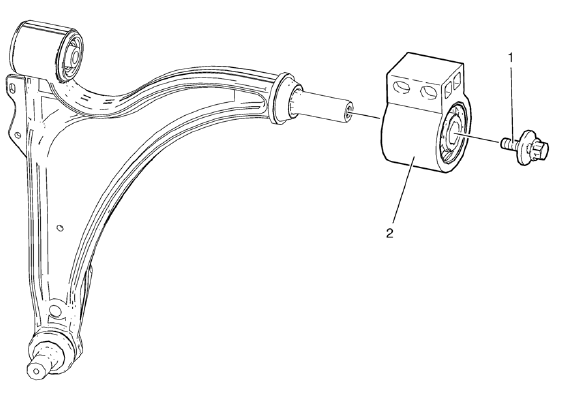Chevrolet Cruze Repair Manual: Front Lower Control Arm Bushing Replacement

Preliminary Procedure
- Raise and support the vehicle. Refer to Lifting and Jacking the Vehicle.
- Remove the tire and wheel. Refer to Tire and Wheel Removal and Installation.
- Remove the lower control arm. Refer to Lower Control Arm Replacement.
Lower Control Arm Rear Bushing Bolt
Lower Control Arm Rear Bushing
Caution: Refer to Fastener Caution in the Preface section.
Procedure
- Discard Bushing Bolt and use NEW ONLY.
- Tighten Bushing Bolt with vehicle standing on the ground.
Tighten 55 N·m (41 lb ft) +45-60 degrees
Special Tools
EN-45059 Torque Angle Sensor Kit . Refer to Special Tools.
 Installation Procedure
Installation Procedure
Position the lower control arm (1) in the cradle.
Install and hand tighten the NEW rear lower control arm bushing nuts and
bolts (1).
Install and hand tighten the NEW fro ...
 Wheel Stud Replacement
Wheel Stud Replacement
Special Tools
CH-43631 Ball Joint Remover
For equivalent regional tools, refer to Special Tools.
Removal Procedure
Raise and suitably support the vehicle. Refer to Lifting and
Jacking ...
Other materials:
Removal Procedure
Warning: Refer to Approved Equipment for Collision Repair Warning in
the Preface section.
Warning: Refer to Glass and Sheet Metal Handling Warning in the Preface
section.
Disable the SIR System. Refer to SIR Disabling and Enabling.
Disconnect the negative battery cable. Refer to Bat ...
Interior Lamps Dimming
This group includes lamps which may dim. This group may use a combination of
vacuum fluorescent illumination, LEDs and incandescent
lamps
HVAC control module, head assembly
Rear HVAC control module, head assembly
Radio
Rear seat audio
The instrument panel cluster
The PRNDL lamp, wit ...
Rear Side Door Weatherstrip Replacement - Door Side
Rear Side Door Check Bolt
Caution: Refer to Fastener Caution in the Preface section.
Tighten
25 N·m (19 lb ft)
Rear Side Door Weatherstrip - Door Side
Procedure
Unclip weatherstrip from rear side door.
When removing protective liners from adhesive tape, be care ...
